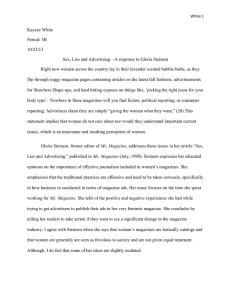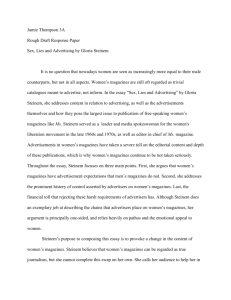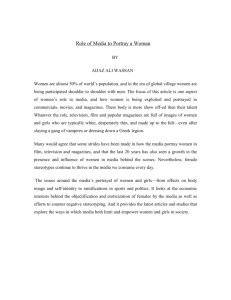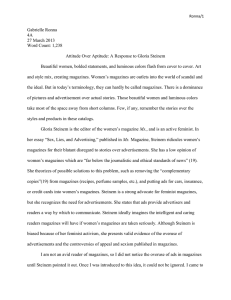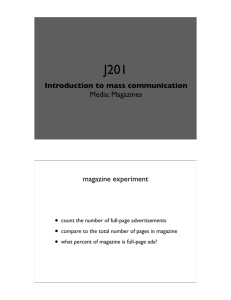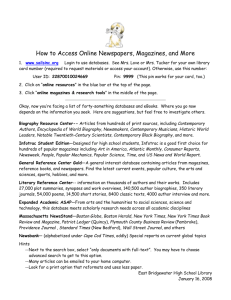Sex Lies and Advertising
advertisement
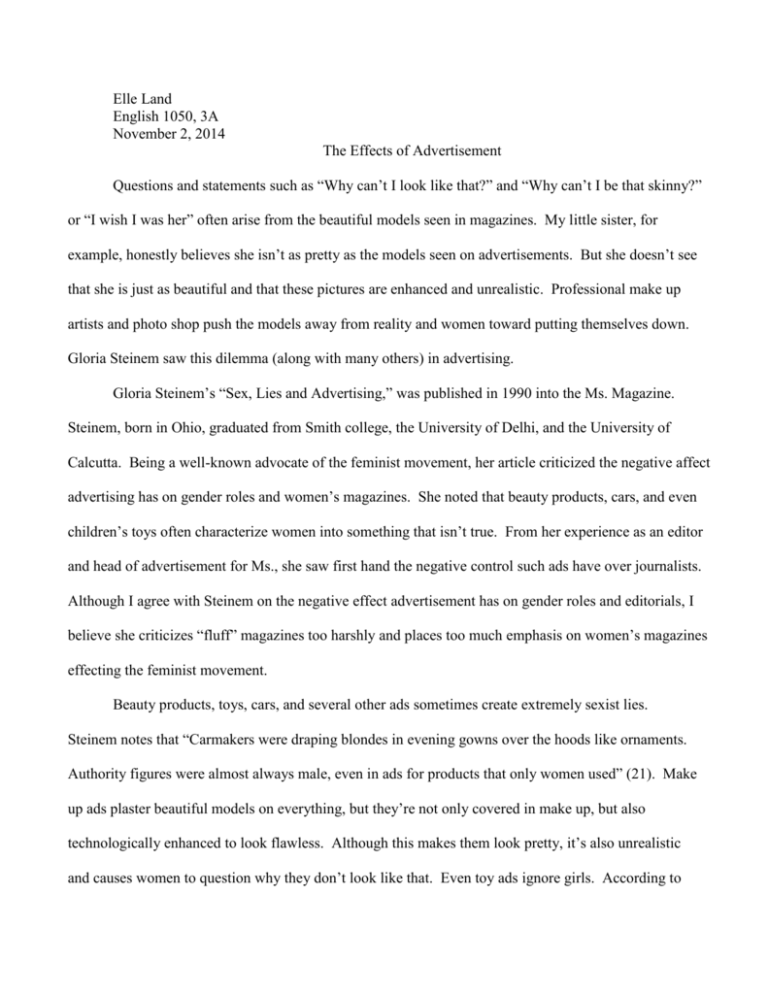
Elle Land English 1050, 3A November 2, 2014 The Effects of Advertisement Questions and statements such as “Why can’t I look like that?” and “Why can’t I be that skinny?” or “I wish I was her” often arise from the beautiful models seen in magazines. My little sister, for example, honestly believes she isn’t as pretty as the models seen on advertisements. But she doesn’t see that she is just as beautiful and that these pictures are enhanced and unrealistic. Professional make up artists and photo shop push the models away from reality and women toward putting themselves down. Gloria Steinem saw this dilemma (along with many others) in advertising. Gloria Steinem’s “Sex, Lies and Advertising,” was published in 1990 into the Ms. Magazine. Steinem, born in Ohio, graduated from Smith college, the University of Delhi, and the University of Calcutta. Being a well-known advocate of the feminist movement, her article criticized the negative affect advertising has on gender roles and women’s magazines. She noted that beauty products, cars, and even children’s toys often characterize women into something that isn’t true. From her experience as an editor and head of advertisement for Ms., she saw first hand the negative control such ads have over journalists. Although I agree with Steinem on the negative effect advertisement has on gender roles and editorials, I believe she criticizes “fluff” magazines too harshly and places too much emphasis on women’s magazines effecting the feminist movement. Beauty products, toys, cars, and several other ads sometimes create extremely sexist lies. Steinem notes that “Carmakers were draping blondes in evening gowns over the hoods like ornaments. Authority figures were almost always male, even in ads for products that only women used” (21). Make up ads plaster beautiful models on everything, but they’re not only covered in make up, but also technologically enhanced to look flawless. Although this makes them look pretty, it’s also unrealistic and causes women to question why they don’t look like that. Even toy ads ignore girls. According to Lionel toy train producers, they can’t put girls on their ads because it will make boys feel less manly and cause them not to want the train. However, ads not only have control over the representation of women, they also control what women read. Steinem constantly struggled with the control ads have over editorials. Several companies refuse to place ads in a magazine unless the journalists write editorials praising the products. Steinem remarks that the readers “don’t need to read articles about these things (products that are advertized)” (30.) For example, food companies refuse to buy advertisement spaces unless the magazine puts recipes that use their product next to the ad. Ms. refused to do this because recipes make women think of work and it’s sexist to put recipes in women’s magazines only (men could enjoy cooking too). Ms.’s cover story of women’s lives in Afghanistan exemplifies another instance of advertisement control over editorials. The story won Front Page award. However, because the women photographed from Afghanistan had no make up on, Revlon removed all ads from Ms.. But are these editorials created by ad companies all that bad? Ignoring that women enjoy reading “fluff” magazines, Steinem critiqued other women’s magazines too harshly. Women find an escape from their daily lives by reading magazines describing how to apply make up and the extravagance of Kim Kardashian’s and Kanye West’s wedding. For example, my grandma babysits and cleans the house every day and at night reads magazines such as More. However, Steinem labeled them “catalogs” and even called them “the antifeminist stereotype of Super Woman.” (32). Even though the content of these magazines isn’t educational, they still hold value. Steinem believed that all editorials praising products should be eliminated, but she ignored that women enjoy reading it. Magazines such as Ms. don’t have as much of a following as fashion magazines such as Vogue. However, Steinem had other flaws in her essay. Steinem also placed too big of an emphasis on the importance of changing women’s magazines. “What could women’s magazine be like if they were as free as books? As realistic as newspapers? As creative as films? ...We’ll only find out if we take women’s magazine seriously” (36). I think that women don’t want to take these magazines seriously and that’s why they buy them. Women’s lives have changed since Steinem was a feminist in the sixties, making her ideas are outdated. Women transformed from the traditional “stay-at-home-mom” to a more career oriented life without any change in the content of magazines. Steinem’s critical analysis of advertising has some good points. They characterize women in wrong ways and have too much control over editorials. However, she also has a biased as a feminist and as editor for Ms.. She hoped to make Ms. more popular and tried to achieve this by criticizing other popular women’s magazines. She also forgot that in women’s busy lives they enjoy reading the fluff filled magazines and that magazines don’t have as big of an impact as she believed they do. Works Cited Steinem, Gloria. “Sex, Lies, and Advertising.” Ms. (1990)
